The Solar surface

Layers, solar wind, sunspots & the solar cycle, faculae, solar flares, CMEs and solar storms, Image Credits: SDO (Source)
So, before moving more into the subject, I would like to first clear it, that the Sun doesn’t actually have a definite surface as such , as it composes only of hot (very hot) gases and plasma. The surface is what we perceive to be a boundary when we observe the sun. However, we just take the topmost layer of the sun, the photosphere, to be the surface, whose light reaches us and is not absorbed or reflected back in by the envelope of gases. (Mind it, the sun has six zones – the core, the radiative zone, the convective zone, the photosphere, the chromosphere, and the corona (or atmosphere), however the photosphere is the deepest layer visible, beyond which the Sun goes opaque, and hence it is considered the surface.) So now, let’s see some spectacular facts about the star of our system.
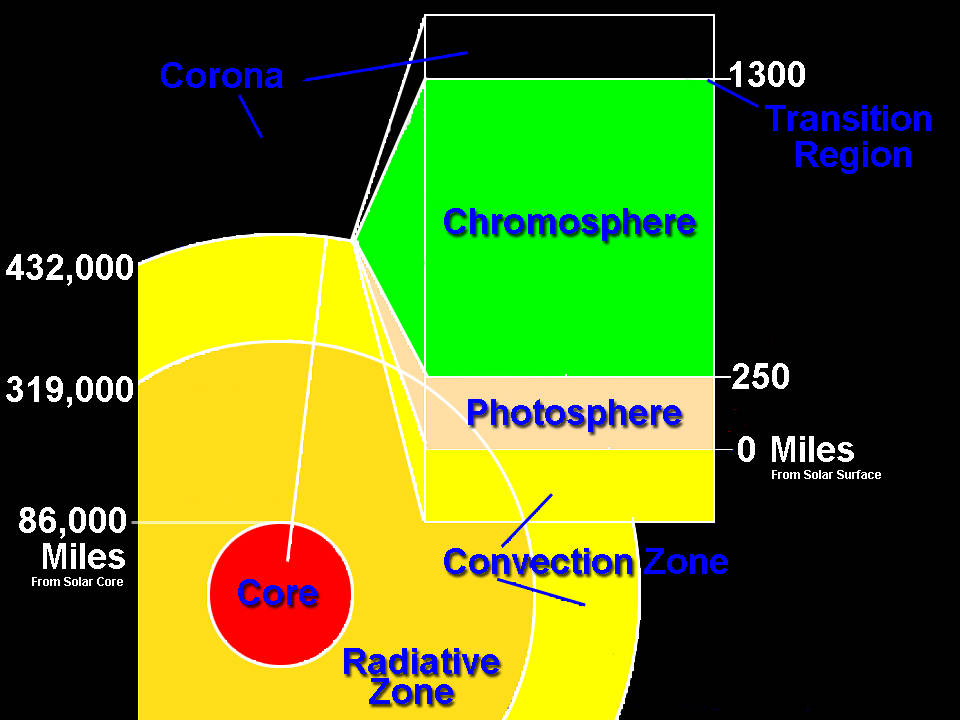
Image credits: nasa.gov (Source)
The photosphere begins from about 7 lakh kms from the Sun’s centre, till about 400 km, beyond which the chromosphere begins. A very interesting phenomenon of these topmost two layers is that unlike from the core to the surface of the sun, the temperature increases with altitude rather than decreasing. In fact, the temperature in the photosphere ranges just from 6000 K to 4000 K, while the chromosphere reaches 8000 K. More surprisingly, the temperature suddenly surges to more than half a million Kelvins in the corona. The reasons for this are as yet unknown, but is most probably explained by magnetic reconnection. Magnetic reconnection is when two magnetic fields of antiparallel directions collide, merging and going out sideways, taking matter particles with them and ejecting a lot of heat in the process. The only thing is, it happens way faster than predicted by current calculations.
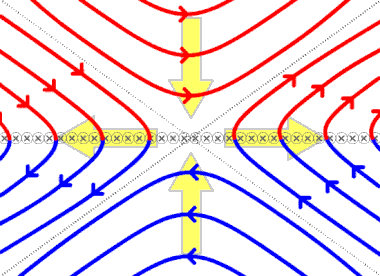
GIF credits: wikipedia.org (Source)
I would recommend watching the animation on the site itself, and also check out a video or two about magnetic reconnection on YouTube, to understand how it works on the Sun’s surface (causing flares and CMEs) as well as Earth’s magnetic tail (causing auroras, although they are caused by direct matter penetration through the Earth’s magnetosphere’s cups too).
Next comes the chromosphere. It is invisible by the naked eye (don’t try to check it without protective glasses!), and requires sophisticated instruments to see it, due to the overwhelming brightness of the photosphere beneath. However, its reddish colour is often revealed during solar eclipses, the only time when one can see it and the corona (which appears like a golden crown, hence the name). With not that many prominent features (except maybe plages and Moreton waves , a subject of their own), this region is yet to undergo much study, although scientists are always looking at it to predict space weather and observe solar prominences (loop-like extensions of matter from sun’s surface).
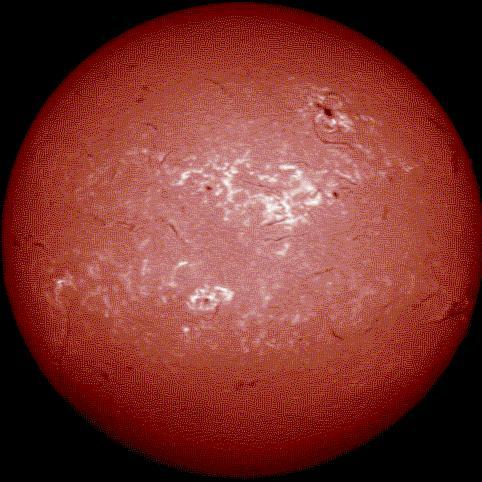
Image: Sun in H-alpha and other hydrogen emission lines, which are highly produced in the chromosphere
Credits: wikipedia.org (Source)
The sparse, but extremely hot Corona is the subject of a greater awe. With temperatures, ranging from a half to a few million Kelvins, this volume is ruled by magnetic fields, solar flares and mass ejections.
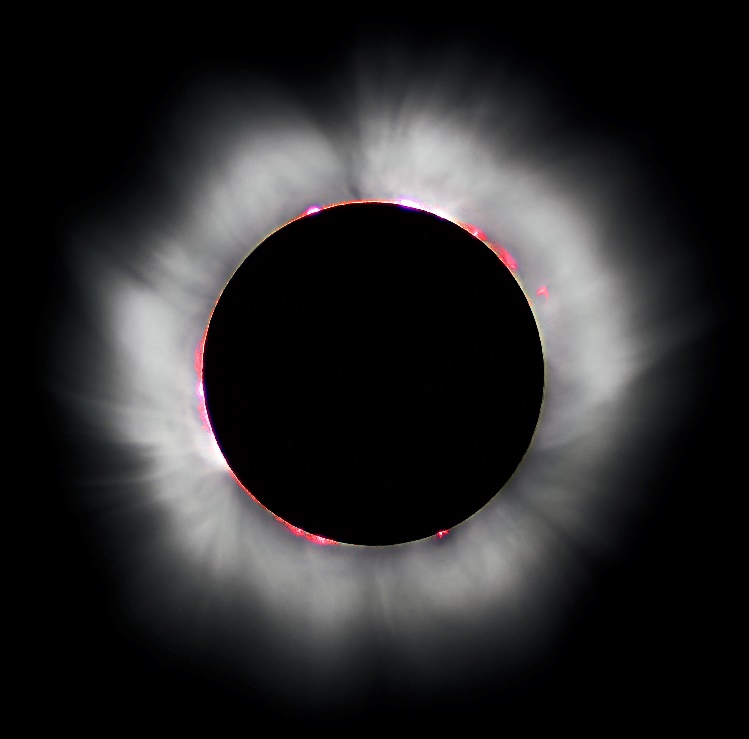
Image: A total solar eclipse, clearly showing the chromospheric prominences (red) and the corona (white)
Credits: wikipedia.org (Source)
In fact, even if humans could possibly design some object that could withstand the surface temperature of the sun, it would never get anywhere close to the surface before being vaporised in the corona itself. It has no definite outer boundary, and particles continuously escape it, leading to what we call, solar wind, a constant flow of particles from the sun.
Solar wind consists of matter from solar plasma , mostly consisting ionised H and He (i.e. alpha particles, protons and electrons), along with traces of heavier (C, O, N, Si, S, Fe, etc.) elements. Sometimes, the wind surges momentarily due to solar surface eruptions. These particles, if they reach the Earth’s surface, are a potential risk to life on Earth. However, as these particles are ionised, and hence charged, they get deflected by our planet’s magnetic field, preventing the damage they can cause. The wind continuously moves outward until a certain distance, after which it goes sideways flowing towards the tail of the heliosphere, whose shape is apparently due to a bow shock , a phenomenon occurring when interstellar wind meets sun’s magnetosphere, forming a shape similar to when Earth’s magnetosphere interacts with solar wind.
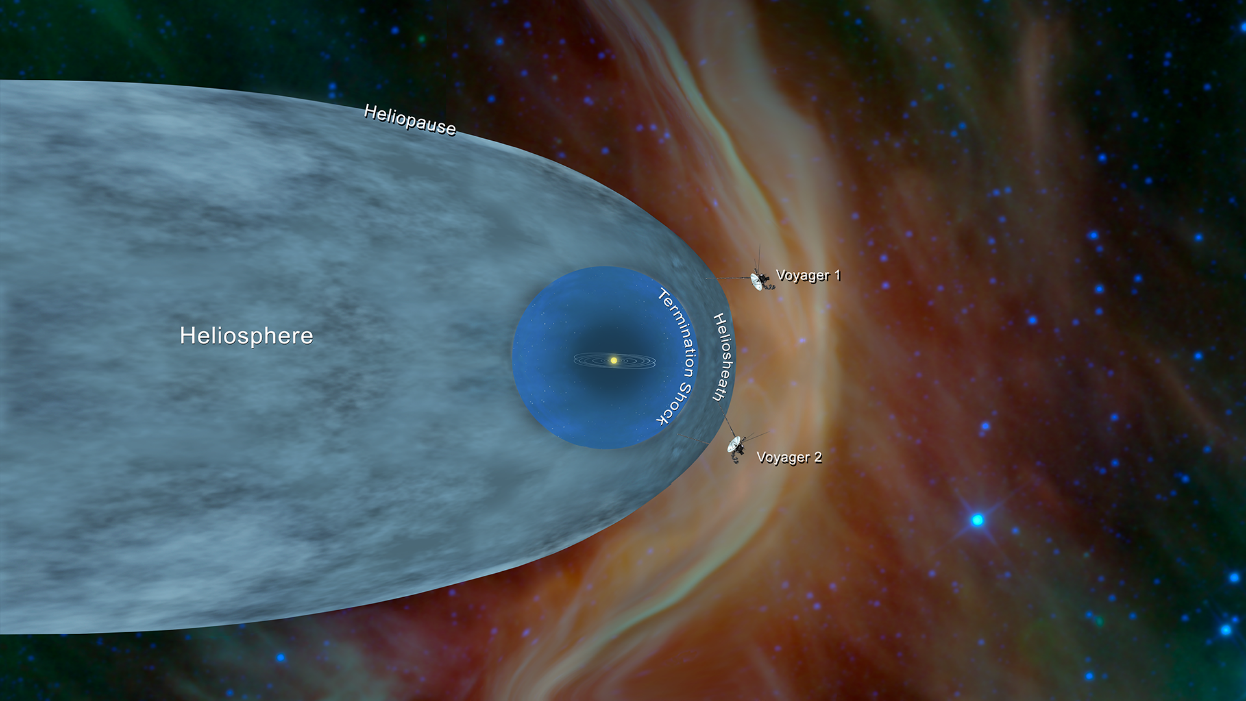
Image: Artist’s impression of the Heliosphere, along with estimated locations of the twin Voyagers
Credits: NASA/JPL-Caltech (Source)
As we can see, just as Earth’s magnetosphere protects our planet from the solar wind, the heliosphere, protects our Solar system from interstellar winds and cosmic radiation. Zooming in on the sun’s surface, we observe bright spots with dark boundaries on the sun’s surface, called granules, which look like cells.
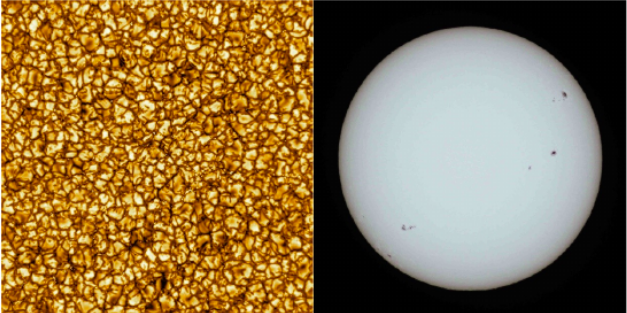
Image 1) Highest resolution picture of Sun’s surface
Credits: Daniel K. Inouye Solar Telescope (Source)
Image 2) Sun in visible showing two sunspots at the right
Credits: wikipedia.org (Source)
These have a life span ranging from a few minutes to a day, depending on their size, and get continuously created and destroyed. They however are too small to be seen by any weakly aided eye. However, often there are quite huge dark spots on the surface, which can easily be identified due to their sheer size, and are called Sunspots. These are cool regions on the surface, and can last for quite long (a few days to few months). They almost always occur in pairs, and are caused by magnetic fields inhibiting convection currents at the poles of the temporary magnetic dipole. They can be so large as to be visible from Earth without the aid of a telescope (but with protection!). Their frequency and magnitude vary, depending more or less on the 11-year solar cycle.
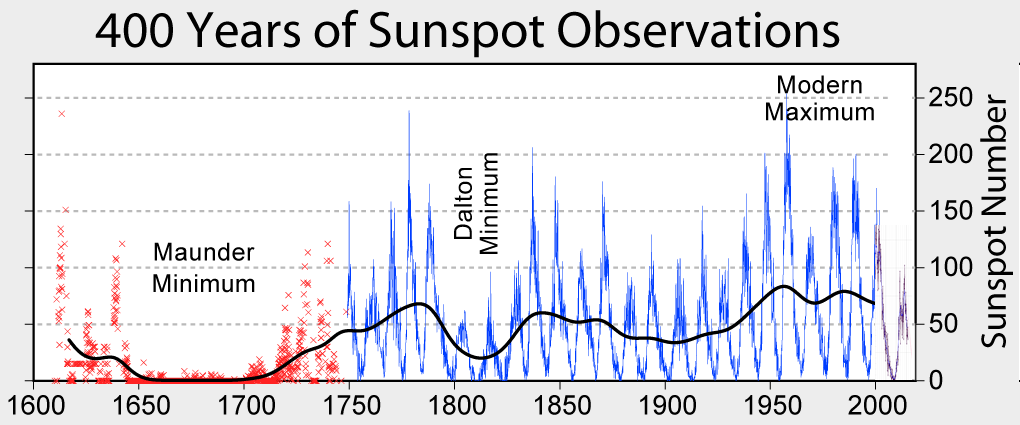
Image credits: wikipedia.org (Source)
The solar cycle is a cycle between solar maxima and minima, corresponding to increase and decrease in solar activity (or number of sunspots), which occurs because Sun’s north and south poles interchange places in approximately every 11 years (so you may say, more accurately the cycle is 22 years long), each transition leading to increase in no. of sunspots , solar flares & eruptions , and prominences . The cycle’s maxima and minima are mostly determined by the number of sunspots observed. Again, reasons for this are as yet unknown. Surprisingly, Jupiter is considered among a possible reason for the solar cycle! As to why, mainly Jupiter (with 70% planetary mass) determines where the centre of mass of our solar system will be. This movement of the centre of mass, can drive convection currents within the star, leading to shifting magnetic flux . And quite supportive of this amazing possibility, Jupiter has a revolution cycle of 11.9 Earth years!
If you wondering that just like dark spots, are there bright spots too, the answer is yes. Although not common, and moreover difficult to observe on the already luminous sun, faculae (and their counterpart on the chromosphere, plages) are brighter regions on the Sun’s surface, which form at the boundaries of huge granules, due to concentration of magnetic field. As one could guess, their proximity to dense magnetic field, also means that they mostly occur nearby sunspots, and last several minutes.
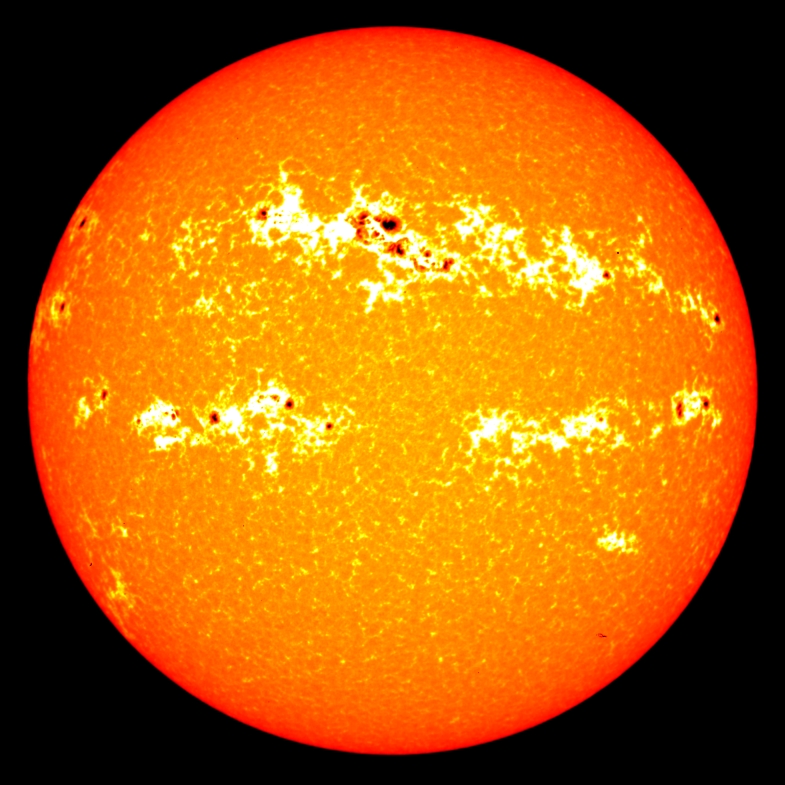
Image: Faculae, alongside sunspots during high solar activity period
Credits: NASA/GSFC, University of Colorado/LASP, HAO & NSO PSPT, GST (Source)
And finally, the eye-catching events, that look both beautiful and petrifying, solar flares and CMEs (short for coronal mass ejections) have been a subject of intense study, as they contribute greatly to the space weather , predicting which is crucial to satellites and astronauts up above, and even us on Earth. Small ejections from the Sun, have been known to have led to colourful auroras visible near the poles. They cause no significant effect here on Earth. Several big events, however, have caused disturbance to radio communications, power grid shutdowns and even induced ground currents (not to mention the magnificent auroras).
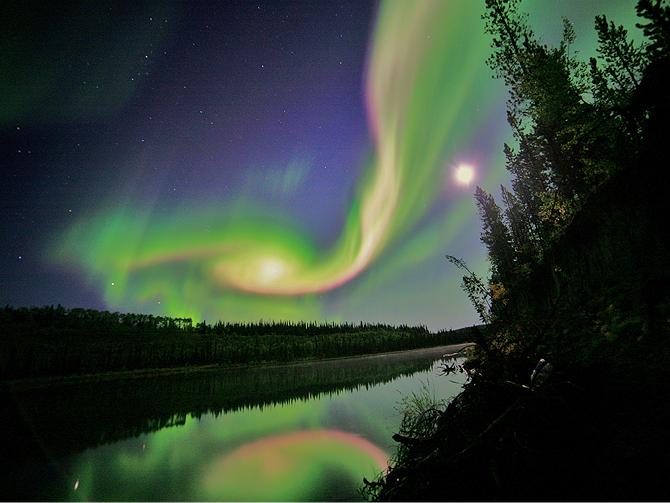
Image credits: NASA/GSFC (Source)
One such big event, causing the largest known geomagnetic perturbation, known as the Carrington event of 1859, was a solar storm that took down several newly developing telegraph operators of the US, staring fires, while some operators could operate their lines even without batteries, owing to the storm-induced current in their lines! (In fact, it is reported that one pair in Massachusetts could communicate for as long as two hours without any manmade electrical supply!)
This video below, showing a computer simulation, could help understand the effect of magnetic field outbursts from the Sun on Earth and how big CMEs are potentially dangerous.
As both solar flares and CMEs, are caused by magnetic reconnections, and involve release of high energy plasma and radiation into space, they are often confused with each other, or thought to be the same. However, solar flares are quite local events to the Sun’s atmosphere, releasing high frequency radiation and some amount of plasma from Sun’s outer atmosphere into space, leading to little to not much change in the particulate output of the Sun into space, and some prominent energy release. In fact, a solar flare would do no more damage to say Venus, which is already pounded on by persistent solar wind.
CMEs however, are a different class of their own. They grow like a huge bubble of plasma over a period of many hours, to a size way bigger than the Sun itself, and finally burst, releasing a huge amount of hot, magnetised particles into the surroundings, intensifying solar wind, and bombarding literally everything in their path. Hence, unlike flares, from which mostly radiation and a few particles in the direction of Earth manage to reach us, CMEs lead to a short, intense solar wind, and a magnetic storm, distorting our magnetosphere, not to mention the harmful radiation itself. Notice how the bubble had grown (left) , which soon explodes to release solar mass out into the surroundings. The white circle represents the Sun, hidden by a coronagraph to picture its surroundings.
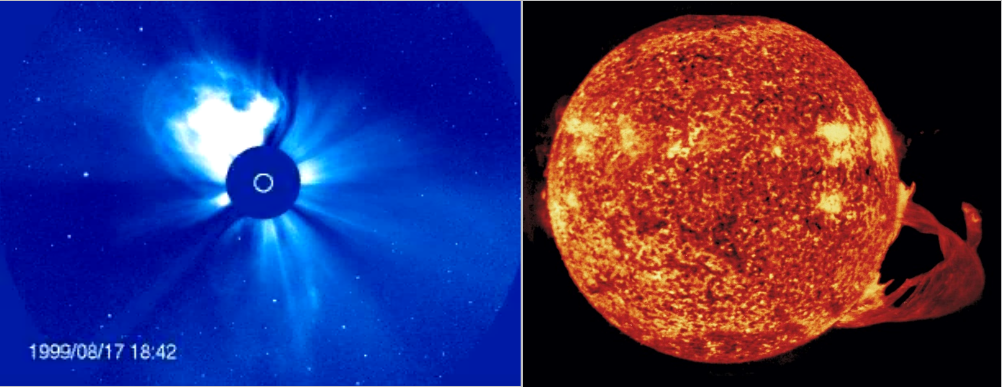
Image 1 credits: TRACE (Source)
Image 2 credits: Skylab 4 (Source)
As you can see, while a flare (right) too is an eruption on the Sun, most of the matter falls back in. Flares mostly can’t even be seen in the visible, as mostly the cloud of emerged ionised gas radiates in X-rays and radio waves. Most flares occur nearby sunspot gatherings, due to high magnetic gradients there, and hence their frequency too depends on the solar cycle, although flares do can occur in absence of sunspots. However, CMEs can easily be observed with the help of a coronagraph (used to block the rays of the sun itself). Although the relationship between solar flares and CMEs isn’t quite established, CMEs are often preceded/accompanied by large flares, and so flares can be a sign that ‘A storm is coming!’. So, although flares and CMEs are different (yet similar), they can occur in the presence (or absence) of each other.
And finally, solar storms, which are somewhat poorly defined, include any solar emission event that can have an effect on the rest of the Solar system. It can include large flares, CMEs, geomagnetic storms (interaction between Earth’s magnetosphere and Sun’s magnetic field outburst) or shock wave accelerated solar winds. It is virtually any potentially short term, hazardous, solar emission event to astronauts, satellites and even Earth, and are a crucial factor considered in space weather.
As you are still reading, I am very happy to that you have reached reading till here, and you really want to know about our Sun. So, I would like to suggest you to check out a few things like our Sun’s structure, the heliosphere, Earth’s magnetosphere, Sun’s tachocline, etc., to understand just how lucky we are, to have got the perfect star to provide heat and energy, the perfect planet to live on, the perfect atmosphere and magnetic field to protect us, and the just perfect distance between them to be safe from heat and radiation, but not freeze up.
References
 Never miss a story from us, subscribe to our newsletter
Never miss a story from us, subscribe to our newsletter